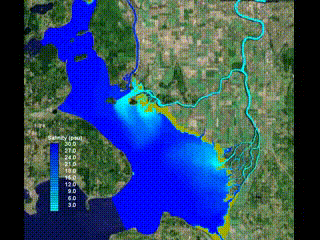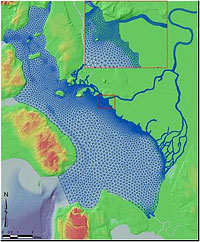SSM Habitat Restoration: Rawlins Road
Rawlins Road/Fir Island Restoration Study, Washington

The Skagit River delta provides rich estuarine and freshwater habitats for salmon and many other species of wildlife. Over the past 150 years, economic development in the Skagit River delta has resulted in significant losses of wildlife habitat, particularly due to construction of dikes. This has resulted in disconnected and isolated the pathways of freshwater and natural sediment to the mudflats and tidal marsh area near the river delta. The Skagit River delta enclosed within the dike and currently used for agriculture is known as Fir Island. Irrigation practices for agriculture land over last century have caused soil to become progressively saturated and resulted in land subsidence on Fir Island. Diking has also reduced the efficiency of the drainage network and impeded fish passage through the area. The objective of this project is to increase the productivity of habitat, expand migratory opportunity, and restore landscape ecological processes through modifications to dikes and hydraulic and hydrologic features, all with minimum impact on current land use.

Battelle supported the Skagit Watershed Council in evaluating the feasibility of restoring natural tidal functions through modification of the dikes near the Rawlins Road region of the northwest corner of Fir Island. Battelle developed a three-dimensional tidal circulation model for the Skagit River delta to assess feasibility of estuarine restoration alternatives using the Finite Volume Coastal Ocean Model (FVCOM ). The hydrodynamic model was calibrated using field data and applied to simulate different restoration alternatives and provided guidance for estuarine restoration and management.
). The hydrodynamic model was calibrated using field data and applied to simulate different restoration alternatives and provided guidance for estuarine restoration and management.
Project Highlights
- Hydrologic models HEC-HMS and UNET developed by the Hydrologic Engineering Center U.S. Army Corps of Engineers were used to simulate drainage inside the diked region of Fir Island and ensure proposed actions did not adversely affect existing land use or drainage.
- The hydrodynamic model application showed that the restricted diked nature of the North Fork of Skagit River coupled with high flow results in a large freshwater plume with no salt wedge.
- Model results indicated that diversion reconnecting the North Fork and Skagit Bay through Hall Slough has very good potential to improve the estuarine habitat in the bay-front area in terms of required salinity distribution (reduction in salinity from existing levels).
Contacts and Project Team
- PNNL: Tarang Khangaonkar (CO-PI), Zhaoqing Yang (CO-PI)
- Skagit Wateshed Council: Shirley Solomon
Study Reports and Publications
Yang Z and T Khangaonkar. 2006. Hydrologic and Hydrodynamic Modeling of the Skagit River Estuary - Rawlins Road Restoration Feasibility Study. Battelle PNWD-3692,prepared for Skagit Watershed Council, by Battelle Pacific Northwest Division, Richland, WA.
Yang Z and T Khangaonkar. 2009. Modeling tidal circulation and stratification in Skagit River estuary using an unstructured grid ocean model. Ocean Modeling, 28(1-3):34-49. doi: 10.1016/j.ocemod.2008.07.004.